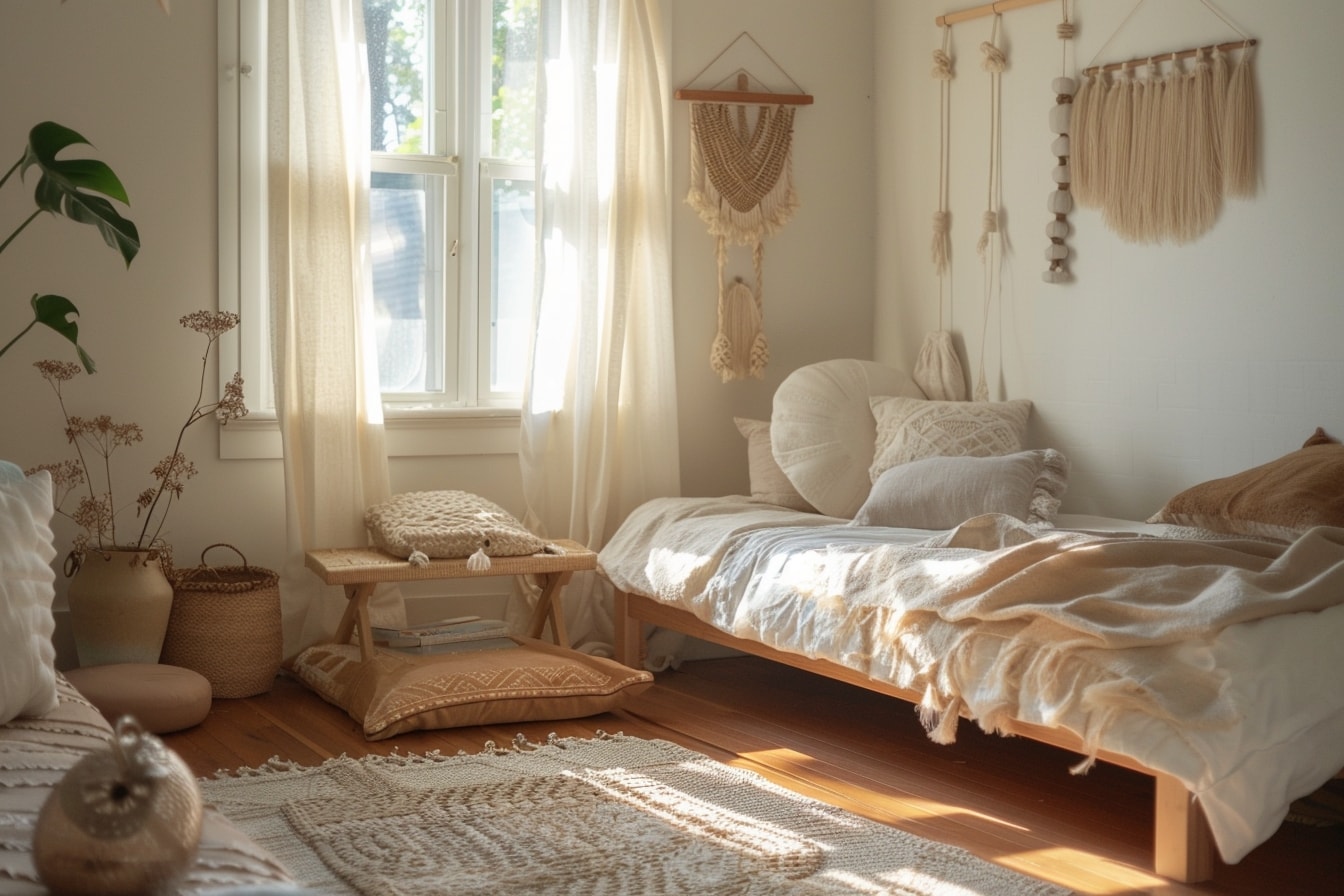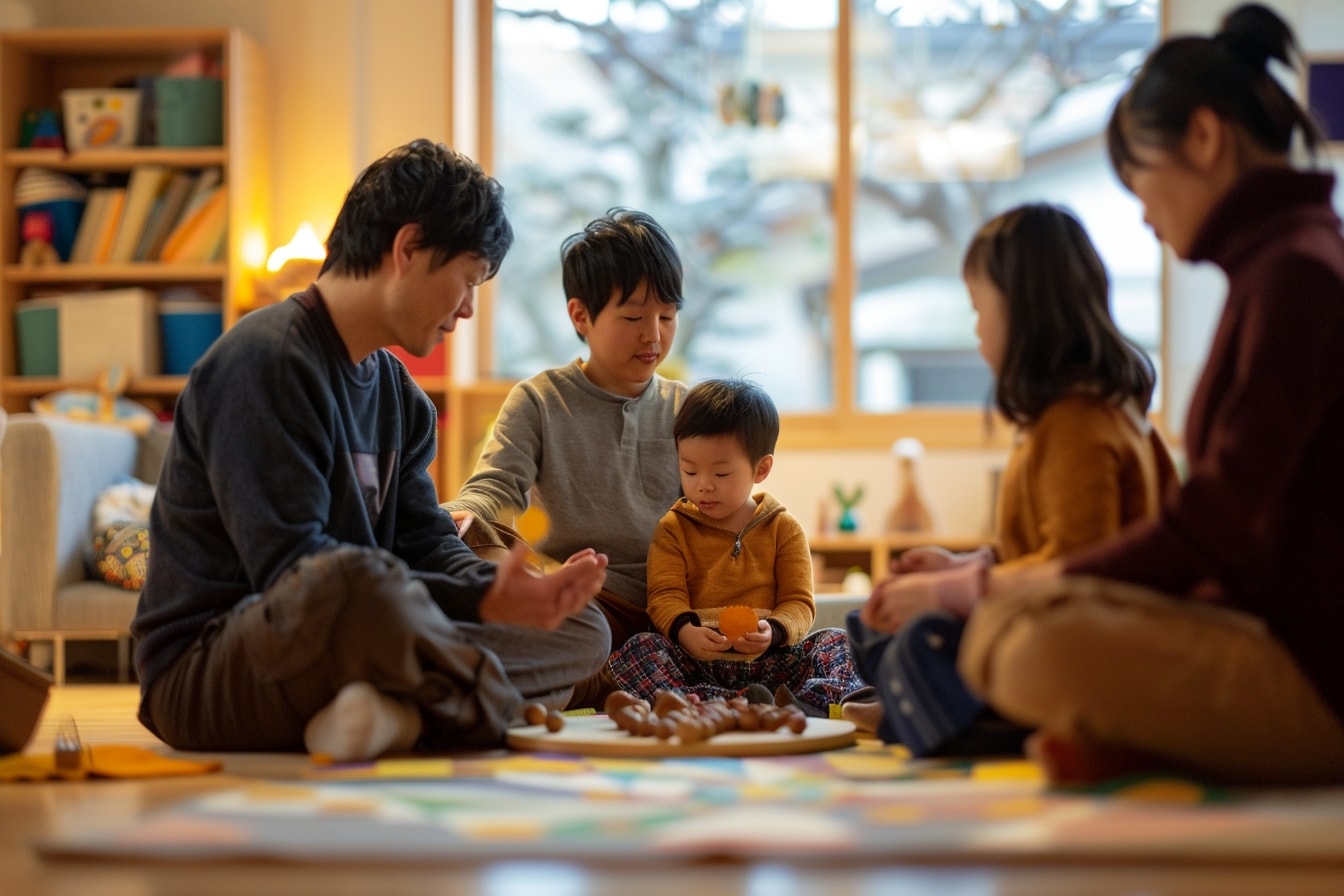Table of Contents
ToggleMontessori and Sleep: Creating a Calm and Cozy Environment
Have you ever found yourself in the middle of the night, exhausted yet endlessly rocking your baby in hopes of coaxing them into sleep? Or perhaps you’ve struggled with the guilt of leaving your toddler to cry themselves to sleep, wondering if there’s a better way to instill healthy sleep habits without compromising your bond?
As parents, the quest for peaceful nights and rested mornings is a universal one. We seek solutions that not only promote healthy sleep for our little ones but also honor their individuality and foster independence. This is where the principles of Montessori education intersect beautifully with the realm of sleep.
Montessori philosophy, with its emphasis on respect for the child, fostering independence, and creating environments that support natural development, offers a refreshing perspective on how we approach sleep in the early years. It’s about more than just a cozy bed and a set bedtime routine; it’s about cultivating a nurturing sleep environment that honors the child’s autonomy and encourages exploration.
In this article, we embark on a journey to explore the intersection of Montessori principles and sleep, delving into how we can create a calm and cozy environment that promotes restful nights and joyful mornings for both parents and children alike.
So, grab a cup of tea, settle into your favorite chair, and let’s discover how to infuse your child’s sleep space with the magic of Montessori.

Designing a Montessori-Inspired Sleep Space
When it comes to creating a sleep environment inspired by Montessori principles, simplicity and functionality are key. Gone are the days of elaborate cribs and overstimulating decor; instead, we aim to cultivate a serene space that invites exploration and promotes independence.
First and foremost, let’s consider the furniture. In a Montessori-inspired sleep space, low furniture reigns supreme. Opt for a mattress placed directly on the floor or a low-profile bed frame that allows your child to easily climb in and out on their own. This not only encourages independence but also eliminates the risk of falls from traditional cribs.
As for decor, less is truly more. Choose neutral colors and natural materials to create a calming atmosphere conducive to restful sleep. Soft, organic bedding invites your little one to snuggle up and drift off into dreamland, while a few carefully selected toys or books on low shelves encourage exploration and foster a love for learning.
Accessibility is another cornerstone of Montessori design. Arrange the sleep space so that everything your child needs for a comfortable night’s rest is within reach. Keep bedtime essentials like a water bottle, a favorite stuffed animal, or a comforting blanket easily accessible on a low shelf or in a basket beside the bed.
Consider incorporating elements of nature into the sleep space as well. A potted plant or a nature-inspired mobile adds a touch of serenity and invites your child to connect with the natural world even as they drift off to sleep.
Remember, the goal of a Montessori-inspired sleep space is to empower your child to take ownership of their sleep routine and environment. By designing a space that prioritizes simplicity, functionality, and autonomy, you set the stage for restful nights and joyful mornings filled with wonder and exploration.

Creating a Calming Bedtime Routine
When the sun sets and the day begins to wind down, establishing a calming bedtime routine sets the stage for a peaceful transition to sleep. In the world of Montessori, consistency and tranquility are the cornerstones of bedtime rituals, guiding little ones towards restful slumber and fostering a sense of security and well-being.
Start by dimming the lights in the evening to signal to your child’s body that it’s time to wind down. Soft, ambient lighting creates a cozy atmosphere and encourages relaxation, helping to ease the transition from playtime to bedtime.
Engage in quiet, soothing activities in the hour leading up to bedtime. This could include gentle yoga stretches, quiet music, or a calming bath to wash away the day’s excitement and prepare the body and mind for sleep.
Reading bedtime stories together is a cherished tradition in many households, and for good reason. Choose books with gentle, calming themes that promote a sense of tranquility and comfort. Snuggle up together under a soft blanket and let the soothing rhythm of your voice lull your little one into a state of relaxation.
As you tuck your child into bed, take a moment to express your love and affection. Offer a gentle massage or a soothing bedtime song to help your little one feel safe and secure as they drift off to sleep.
Remember, the key to a successful bedtime routine is consistency. Establishing a predictable sequence of events signals to your child’s body that it’s time to sleep, helping them to feel more secure and relaxed as they settle down for the night.
- Dim the lights to create a cozy atmosphere
- Engage in quiet, soothing activities like yoga or a bath
- Read bedtime stories with gentle, calming themes
- Express love and affection through gentle touch and soothing songs
By incorporating these elements into your bedtime routine, you can create a calming and nurturing environment that promotes restful sleep and sweet dreams for your little one.

Understanding Sleep Needs and Patterns
As parents, one of our greatest responsibilities is ensuring that our children get the restorative sleep they need to thrive. Understanding their sleep needs and patterns is crucial in this endeavor, and in the world of Montessori, it’s about honoring each child’s unique rhythm and allowing them the freedom to follow their natural sleep cues.
First and foremost, it’s important to recognize that sleep needs vary depending on age and individual differences. Newborns require significantly more sleep than toddlers, and as children grow, their sleep patterns evolve. By familiarizing yourself with age-appropriate sleep guidelines and paying attention to your child’s cues, you can better meet their sleep needs.
Montessori philosophy emphasizes the importance of observing and respecting the child’s natural development. This extends to sleep, where children are encouraged to follow their own internal clock rather than adhering to rigid schedules imposed by adults. By tuning into your child’s sleep patterns and recognizing their unique sleep cues, you can better support their natural sleep rhythms.
Signs of tiredness can vary from child to child, but common indicators include rubbing their eyes, yawning, and becoming fussy or irritable. By recognizing these cues and responding promptly, you can help your child transition to sleep before they become overtired, making the process smoother and more peaceful for everyone involved.
It’s also important to remember that sleep patterns can fluctuate, especially during periods of growth or development. Be prepared for changes in your child’s sleep routine, and remain flexible in your approach to bedtime and naptime. By adapting to your child’s evolving sleep needs, you can create a sleep environment that promotes restful nights and happy mornings.
- Recognize age-appropriate sleep needs
- Observe and respect your child’s natural sleep rhythms
- Respond promptly to signs of tiredness
- Remain flexible in your approach to bedtime and naptime
By understanding your child’s sleep needs and patterns, you can create a sleep environment that honors their individuality and promotes healthy sleep habits for years to come.

Tackling Common Sleep Challenges
Despite our best efforts, navigating the world of sleep with little ones can sometimes feel like a never-ending rollercoaster ride. From frequent night waking to bedtime battles that seem to stretch on for hours, parents often find themselves facing a myriad of sleep challenges. But fear not, dear readers, for in the realm of Montessori, there are gentle yet effective strategies for overcoming these hurdles and reclaiming restful nights.
One common challenge faced by parents is frequent night waking. Whether it’s due to hunger, discomfort, or simply a desire for reassurance, waking multiple times throughout the night can leave both parents and children feeling exhausted and frustrated. In these moments, it’s important to respond with patience and empathy, offering comfort and reassurance while gently guiding your child back to sleep.
Another common sleep challenge is difficulty settling to sleep at bedtime. The transition from wakefulness to sleep can be particularly challenging for young children, especially if they are overstimulated or anxious. Creating a calming bedtime routine, as discussed earlier, can help signal to your child’s body that it’s time to wind down and prepare for sleep. Additionally, providing a consistent sleep environment free from distractions can further facilitate the transition to sleep.
For older children, resistance to bedtime or fears of the dark may present additional challenges. In these cases, it’s important to validate your child’s feelings while also offering gentle guidance and support. Engage in open and honest conversations about their fears and concerns, and work together to find solutions that help alleviate their anxiety and promote a sense of safety and security at bedtime.
As with any challenge, it’s important to approach sleep struggles with patience, understanding, and a willingness to adapt. Montessori philosophy teaches us to view challenges as opportunities for growth and learning, and the same holds true when it comes to sleep. By remaining flexible in our approach and prioritizing our child’s emotional well-being, we can overcome common sleep challenges and create a peaceful sleep environment that fosters restful nights and happy mornings for the whole family.
- Respond with patience and empathy to frequent night waking
- Create a calming bedtime routine to facilitate the transition to sleep
- Validate your child’s feelings and work together to find solutions to bedtime fears
- Approach sleep struggles as opportunities for growth and learning
With perseverance and a commitment to nurturing our children’s sleep habits, we can overcome common sleep challenges and create a bedtime experience that promotes peace, tranquility, and restful nights for all.

Nurturing a Restful Mindset
Creating a restful sleep environment goes beyond the physical aspects of a cozy bed and a calming bedtime routine; it also involves nurturing a peaceful mindset that promotes relaxation and tranquility. In the world of Montessori, mindfulness practices play a central role in fostering a restful mindset for both parents and children, helping to ease the transition to sleep and promote deeper, more restorative rest.
One mindfulness practice that aligns seamlessly with Montessori philosophy is guided relaxation exercises. These simple yet powerful techniques help to quiet the mind and relax the body, making it easier to let go of the day’s stresses and drift off into a peaceful slumber. From progressive muscle relaxation to deep breathing exercises, there are countless ways to incorporate guided relaxation into your bedtime routine.
Another mindfulness practice that can promote a restful mindset is gratitude rituals. Taking a few moments each night to reflect on the things we are grateful for can shift our focus away from worries and anxieties, allowing us to cultivate a sense of peace and contentment that carries us into sleep. Encourage your child to share one thing they are thankful for each night before bed, fostering a sense of positivity and well-being.
Engaging in quiet activities that promote relaxation can also help to nurture a restful mindset. Whether it’s coloring, journaling, or listening to calming music, finding activities that bring joy and peace can help to quiet the mind and prepare the body for sleep. Consider incorporating these activities into your evening routine as a way to unwind and decompress before bedtime.
Finally, prioritizing self-care and stress management is essential for nurturing a restful mindset. As parents, we often put the needs of our children before our own, but it’s important to remember that taking care of ourselves allows us to better care for others. Whether it’s practicing yoga, going for a walk, or simply taking a few moments to breathe deeply and center ourselves, finding time for self-care can have a profound impact on our ability to relax and sleep peacefully.
- Incorporate guided relaxation exercises into your bedtime routine
- Cultivate a sense of gratitude through nightly rituals
- Engage in quiet activities that promote relaxation and peace
- Make time for self-care and stress management
By nurturing a restful mindset through mindfulness practices, quiet activities, and self-care, we can create a sleep environment that supports deep, restorative rest for the whole family.
As we come to the end of our exploration into the intersection of Montessori philosophy and sleep, it’s important to reflect on the key principles and insights we’ve uncovered along the way. From designing a serene sleep space to cultivating a restful mindset, we’ve delved into the elements that contribute to a peaceful bedtime experience for both parents and children.
Throughout this journey, we’ve learned that creating a Montessori-inspired sleep environment is about more than just aesthetics; it’s about honoring the child’s autonomy, fostering independence, and nurturing a sense of peace and tranquility that sets the stage for restful nights and joyful mornings.
We’ve explored the importance of simplicity and functionality in designing a sleep space that promotes exploration and independence, and we’ve discussed the value of consistency and tranquility in establishing a calming bedtime routine that signals to the body and mind that it’s time to rest.
We’ve also delved into the significance of understanding our children’s sleep needs and patterns, recognizing their individual rhythms and responding with empathy and flexibility to ensure they get the restorative sleep they need to thrive.
And finally, we’ve explored the power of mindfulness practices in nurturing a restful mindset, encouraging gratitude, self-care, and quiet reflection as tools for promoting relaxation and tranquility at bedtime.
As we bid farewell to this journey, let us carry forward the wisdom and insights we’ve gained, applying them with patience, understanding, and a commitment to nurturing our children’s holistic development. May your sleep space be a sanctuary of peace and joy, where dreams flourish and hearts are filled with love.
Thank you for joining me on this adventure, dear readers. Here’s to restful nights and bright mornings ahead.
Want to take your knowledge to the next level? Check out these must-read articles:
- The Montessori Approach to Baby-Led Weaning
- Montessori Materials for Babies: Must-Haves for Early Learning
Organize your baby’s wardrobe with our baby clothes closet organizer products! Our organizers are designed specifically for baby clothes. Get your baby’s clothes neat and tidy with our selection of organizers – shop now!
Step into Sue Brown's World of Baby Care, where you'll find a treasure trove of knowledge and wisdom waiting to be explored. Sue's dedication to providing accurate and up-to-date information on baby care shines through in every article, blog post, and resource she shares. From newborn essentials to sleep training tips, breastfeeding advice to nurturing your baby's development, Sue covers a wide range of topics that are essential for every parent to know. Her warm and compassionate approach creates a sense of community and reassurance, making her website a safe haven for parents seeking guidance and support. Let Sue Brown be your partner in this beautiful journey of parenthood, as she empowers you to create a loving, nurturing, and thriving environment for your little one.
- Indoor Air Quality for Infant Respiratory Health - October 20, 2025
- Positive Discipline Foundations: Setting the Stage From Infancy - October 18, 2025
- 2025’s Most Innovative Baby Products Worth the Investment - October 16, 2025



